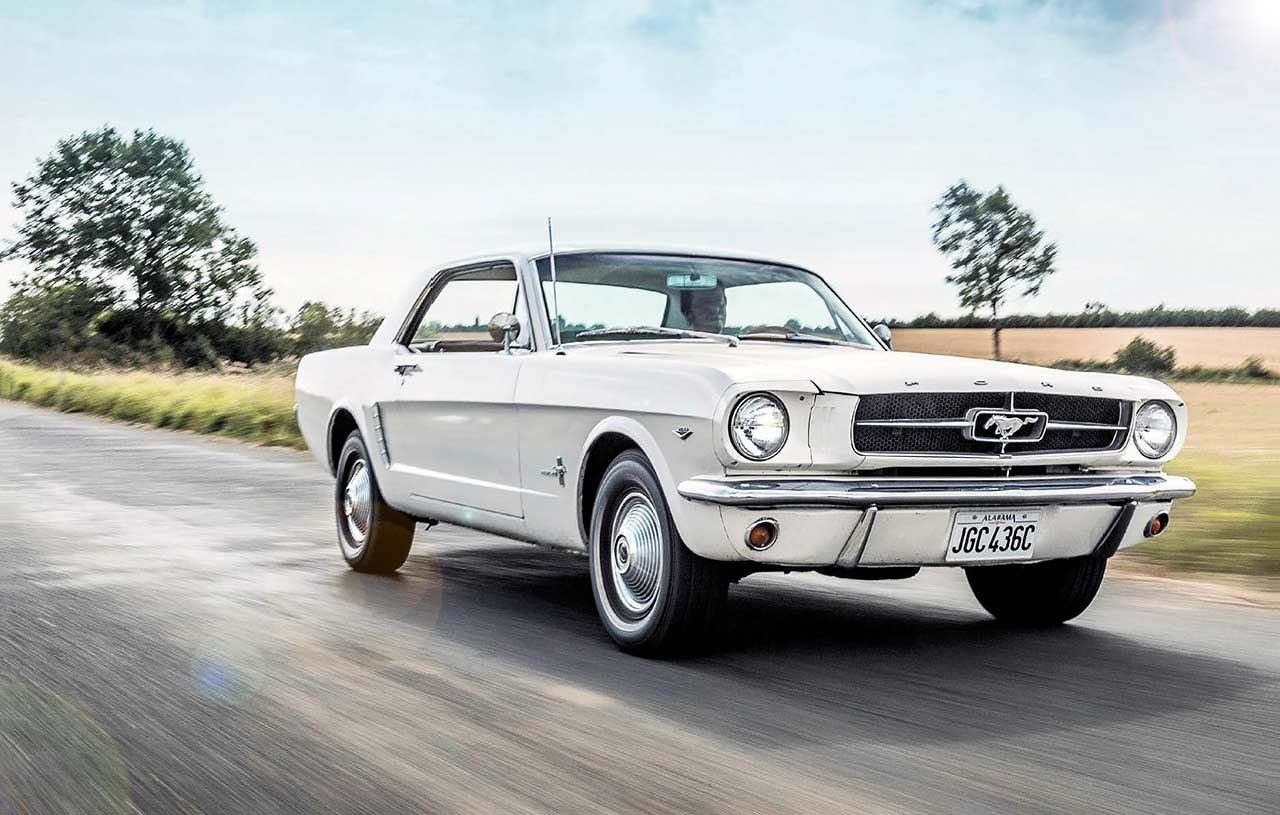
The List “You feel like a movie star” Your dream drive made real Darrin Alker loves how precisely his Lotus Esprit drives – so why on earth did he ask us to put him in a Ford Mustang for the day? Words: Ross Alkureishi. Photography: Alex Taply.
The List The lucky reader this month wanted us to get him out of his own Lotus Esprit and into a Ford Mustang – and as he quickly discovers, the handling gulf between them causes him to recalibrate his driving style…
The Ford Mustang 289 we’ll be using today sits proudly outside Essex-based Affordable Classics. Proprietor Roger Chinery is busy showing me around his workshop, an eclectic shrine to all things Blue Oval, when another white car pulls up next to it and Classic Cars reader Darrin Alker steps out. His Pearlescent White Lotus Esprit Turbo is futuristic looking, hand built, turbocharged – everything the everyman, mass-produced Ford isn’t.
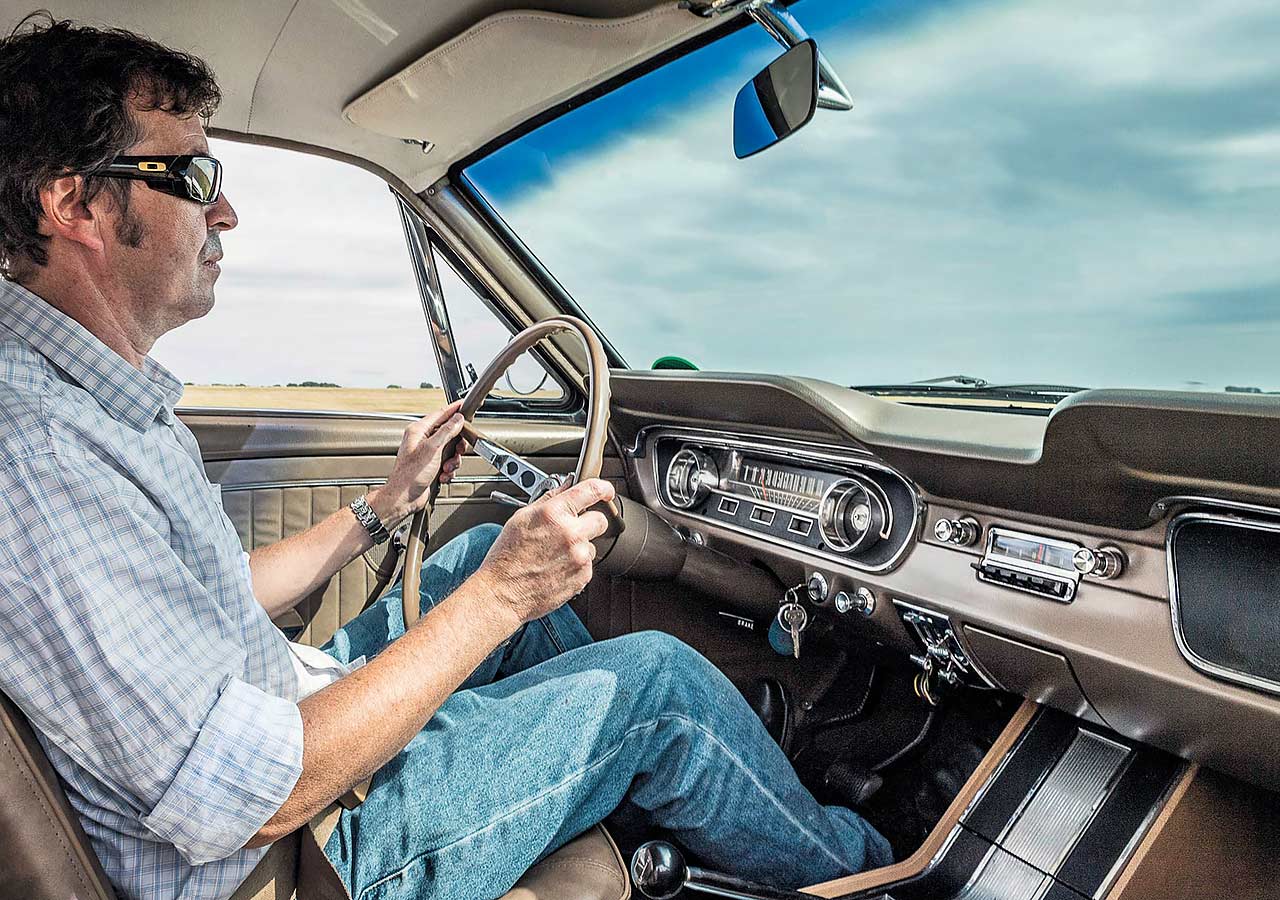
Intrigued, I immediately ask him why the Mustang is on his List. ‘The Lotus has always been my dream car and I’m lucky enough to have one in my garage,’ he explains. ‘I always seem to end up with four-cylinder turbocharged engines and although I’ve driven a few V8s – Jaguar XKR, V8 Esprit and a Range Rover Ambulance – I’ve never had the pleasure of owning one. American ones in particular have a lovely sound to them and when you combine that with the looks, that’s the reason it’s on my List.
Fair play, a nice concise explanation; time to get this North American show on the road. We climb aboard, ix our lap belts and Darrin’s eyebrows rise as he clocks the transmission tunnel. ‘Wow, a manual gearbox, I wasn’t expecting that. Americans don’t usually do stick shifts, I thought all their early cars were autos.’ It’s a dogleg box too, just to add another factor to the pot and ensure he’ll need to keep his wits about him. The small-block V8 fires with that definitive breathy thrum, he disengages the twist-release handbrake and we’re of.
‘You can feel the bottom-end grunt, even just pootling along like this,’ he says, signalling right. We pull out on to the A1017 and with a car fast approaching the Mustang’s rear end he floors the throttle. There’s a surge of torque accompanied by a lazy growl, but our fellow road user is still right behind us. It’s a 50mph road but that doesn’t necessarily mean everyone sticks to it, and our day’s kicked of in a distinctly rushed manner.
I point out we’re taking the next right at the bottom of the hill, but Darrin leaves his braking and steering too late. It’s comedy, almost bordering on tragedy, as we both slide left on our seats and the car leans heavily on its suspension. We make it with the slightest wiggle from the rear end as he corrects matters. Blimey, that was Thelma and Louise dramatic.
He brings the car to a stop 100 yards on. ‘I could see the headline,’ he says, shaking his head. ‘Classic Cars reader writes dream car of on first corner. I applied the brakes and very little happened, I then tried to make the turn to find very little response from the steering; it keeled like a barge hit side-on by a massive wave.’ Perhaps that’s apt, given Darrin spent the early part of his career in the Royal Navy.
‘I thought I took it relatively carefully. It was eventful… or should I say about the controls, uneventful,’ he adds. ‘I kept thinking it’s not turning, please turn – any time now would be nice. They have a reputation for not going round corners and that was all summed up at the first time of asking.’
To be fair to Darrin he’s just stepped out of a machine blessed with seminal handling, built by a company renowned for the nimble-footed prowess it endows its cars with. The Mustang is bordering on antediluvian by comparison. We reach a gentleman’s agreement to put what’s just happened behind us, shake hands, and agree to start again – take two.
This time we settle into smooth cruising on Essex’s deserted country lanes. Burbling along at low revs the engine has lilting, soothing note. ‘I’m getting used to that gear change – it’s easier now, even if it’s still chunky, in a manly sort of way. You’ve really got to take hold of it – perhaps in a Ferrari I’d be scared of breaking it, but this feels like it’s built to last and will take it. The engine makes all the right noise and even the whine from the live rear axle has a charm about it.’
We both agree that the Mustang’s interior has a generic, if a little bland, functionality to it, but still manages to look cool. ‘It’s a pleasant place to be, the seat is reasonably comfortable and that horizontal straight-line speedometer in the centre of the dash is a classic American design,’ says Darrin.
‘I also like the space in the cabin. The beauty of this is I can see everything; the Lotus has distinctly limited visibility.’ I’ve driven a fair few, so know exactly what he means – by comparison, it’s a veritable goldfish bowl in here. ‘The lack of clutter and distractions that so many modern cars have these days is also quite pleasant.’ With his confidence building we head back out onto fast A-roads and settle down into a lazy rhythm, punctuated by heavy throttle bursts when the road straightens out ahead. The driving experience has a mesmeric quality to it and like most of blue-collar Sixties America I can feel us both becoming seduced by the smallblock’s wares. ‘Oh, I could quite happily cruise all day in this,’ offers Darrin. ‘It’s a more relaxed car to drive when you acclimatise to it. Stuff in the back, and away you go on a grand tour.’
Out through another long sweeper and once again the road straightens; this time he’s heavier with the loud pedal and there’s a sea change to a more urgent, harder note. ‘Now that is awesome,’ he purrs. ‘I should have bought one years ago. We’re only getting to around 60mph – it’s not a fast car, but it’s got a certain feel to it. That whole feeling of V8 pulling you forward is glorious, this old girl just glides effortlessly.’
One of the limiting factors here of course, is the three-cog manual gearbox, something not available on the more potent high-performance variants – placing this budget 289 just above the puny six-cylinder car on the 1965 Mustang food chain. Customers could spec their cars to their achy-breaky hearts delight – engine, body style, and performance features could all be upgraded, chosen or tweaked. And of course having perfected the formula Stateside, Ford then pulled the same trick on this side of the pond with its ‘European Mustang’, the Capri.
Not that we’re dealing with faux Americana today. Nope, for us it’s the real deal. My musings are abruptly interrupted by a squeal, the locking up of the rear wheels and an instinctive reach for the dashboard. ‘Sorry about that,’ says Darrin, apologetically.
‘I thought for a second that the brakes had gone, but they’re there and just take a bit of getting used to. It’s a solid pedal, there’s no feel. You have to work them hard, really use your thigh muscles. I’m surprised how sharp they can be.’ You and me both, Mr Alker. Back on the gas, there’s a minor wheel spin as we power on.
‘This car takes you back to a time when to drive a car you had to do it properly, to think ahead and plan accordingly,’ explains Darrin. ‘Nowadays the ABS or another system kicks in. That cerebral element of driving has been removed. ‘Young drivers today don’t know how mollycoddled they are. Take the Nissan GT-R for example – you know I like my Nissans – it makes you look like a great driver. “Oh, I just took that corner at 60mph, I’m a great driver”, but this is raw, undiluted and I must say – fan belt squeak and all – I actually quite like it.’
All this talk of corners at 60mph is apt, because we’re on some seriously twisty terrain and I get the feeling Darrin’s keen to try again. He drops down to second, squeezes the throttle and powers into it; measured is the best word to describe his approach. ‘It so wants to go over there,’ he says, nodding straight ahead. ‘If you enter a corner carrying too much speed it’ll go straight.’ And with that, the back end twitches again.
‘If you let your concentration go even for a second you’ll end up in a hedge, and if you don’t brake quickly enough it’ll lock up and you’ll go into the car in front. I tip my hat to those racing drivers that had to manhandle these around race tracks back in the day.’
We’ve come full circle and now it’s time to turn back on to our nemesis A1017; he checks and double checks both ways, before pulling out.
Our smooth cruise back is punctuated with talk of Mustang legends of old – the Hertz GT350H rental cars and Bullitt Fastback among others – and the car’s styling. ‘It’s such a timeless shape,’ says Darrin. ‘It’s beautiful; aggressive, but not offensive, and it looks just as good as a convertible, fastback or coupé.
‘If you take in the subtle styling cues, Ford basically took a rectangle and put some nice curves in it. The Seventies and Eighties cars, though… ugh. Thankfully, the modern variants have incorporated more of this era’s style.’
Back at the Mustang’s home, Roger, who’s also keen to see what Darrin thought, greets us. ‘With no power steering, no brake servo, no ABS and no computer to get you round the corner, it’s completely analogue,’ explains Darrin.
‘However, I could look past all that because in the background was that roar of the lovely V8. It doesn’t matter that we didn’t go much past 60mph, or how long it took to get there, it’s all about the soundtrack that goes with opening the throttle. It just makes the driver feel like a movie star.
‘You can learn how it drives and adapt to it. Apply the brakes sooner, engage the steering wheel ten feet before the corner – I could easily get used to this. Yes, you sometimes feel you can put your foot out and stop it quicker, so perhaps I’d upgrade the brakes. I’d always thought that American cars’ reputation for poor handling was exaggerated,’ he states.
I cough, and he catches my eye. ‘It’s not,’ he adds, before recounting his first corner experience for Roger’s benefit. The Mustang tapped into the American psyche just as post-war consumerism peaked and the next generation arrived ready and primed for just such a car; cool styling, effortless cruising, affordability and the ability to specify and modify, and blanket high-visibility publicity all factored in to making the car the worldwide legend it became.
So today, despite its design limitations, would our reader like to own one?
‘Yes, without doubt,’ he states, categorically. ‘The next question is, which model and spec and would I choose more power? As he climbs back into his Lotus Esprit Turbo, it’s clear that the thought of it sitting side-by-side with a legendary chunk of American iron is already working its magic on our reader.
Thanks to Roger Chinery at Afordable Classics (affordableclassics. co.uk), where this Ford Mustang 289 is available to hire out for weddings, film and TV work or themed parties.
TECHNICAL DATA FILE SPECIFICATIONS 1965 Ford Mustang 289
Engine 4727cc V8, OHV, two-barrel carburettor
Power and torque 200bhp @ 4400rpm; 300lb ft @ 2800rpm / DIN
Transmission Three-speed manual, rear-wheel drive
Brakes Drums front and rear
Suspension Front: wishbones, coil springs, anti-roll bar. Rear: live axle, leaf springs
Steering Recirculating ball
Weight 1383kg (3049lb)
Performance 0-60mph: 8.9sec; Top speed: 120mph
Fuel consumption 13mpg
Cost new £1922 (HiPo version)
Classic Cars Price Guide £9000-£22,500
‘I tried to make the turn to find very little response from the steering; it keeled like a barge hit side-on by a massive wave’
‘I could quite happily cruise all day in this; stuff in the back and away you go on a grand tour’

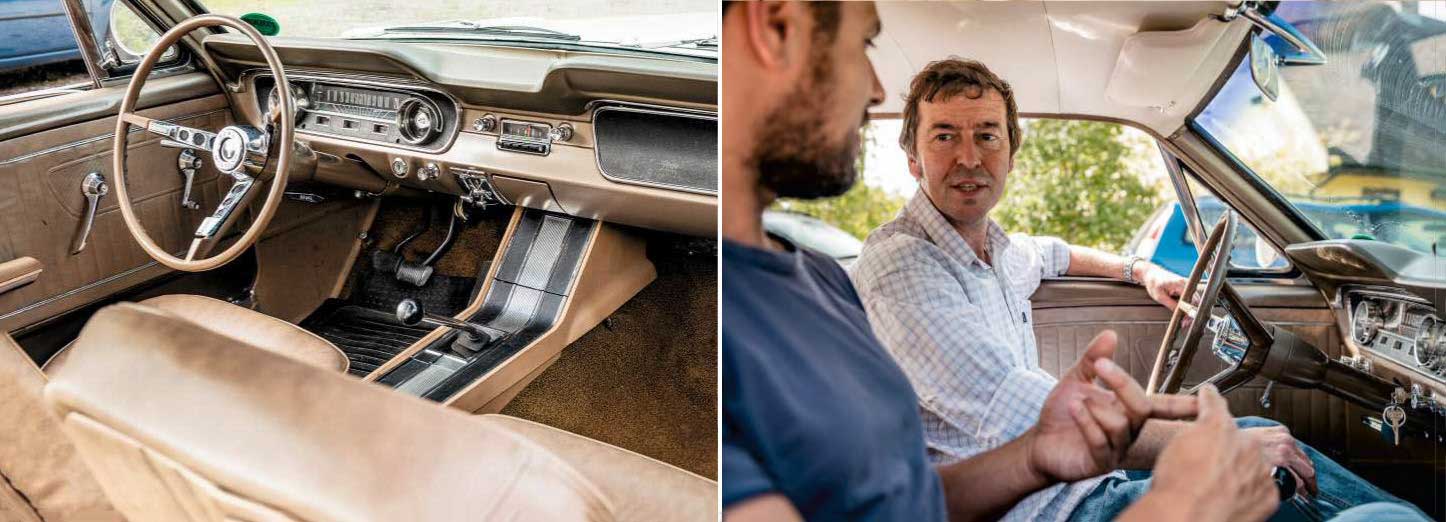
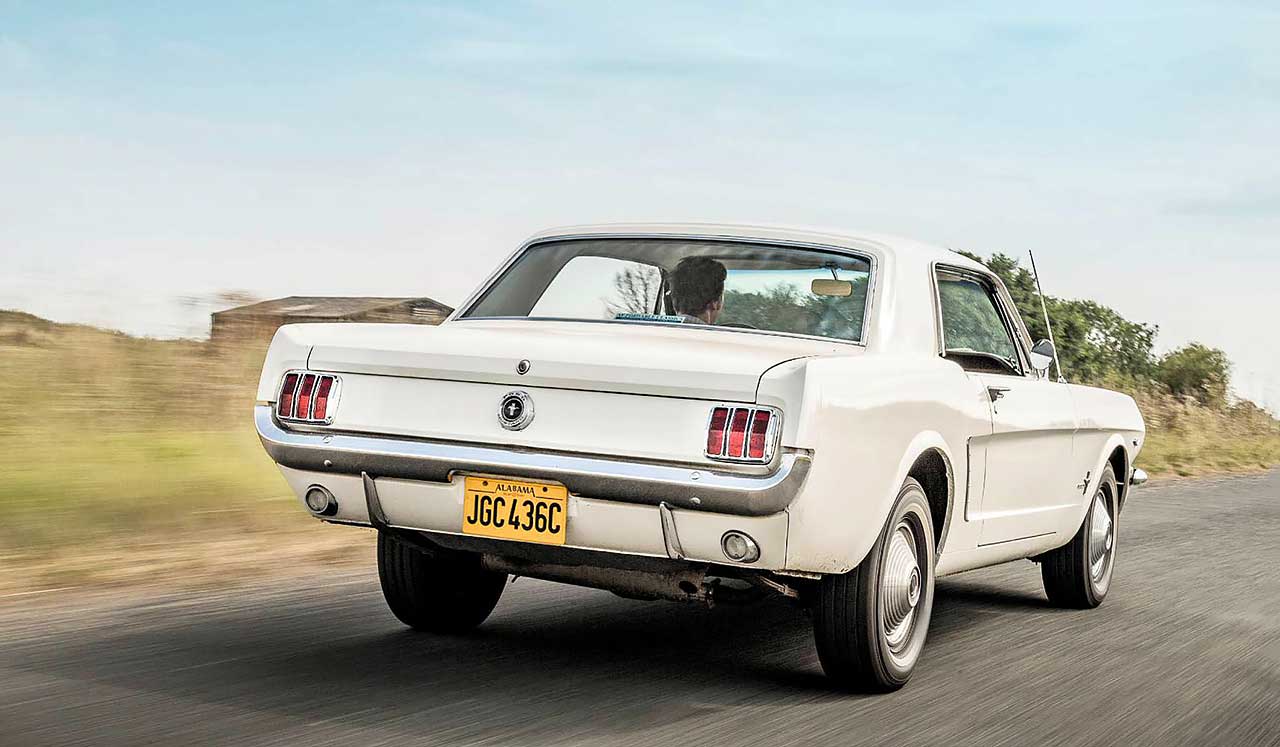
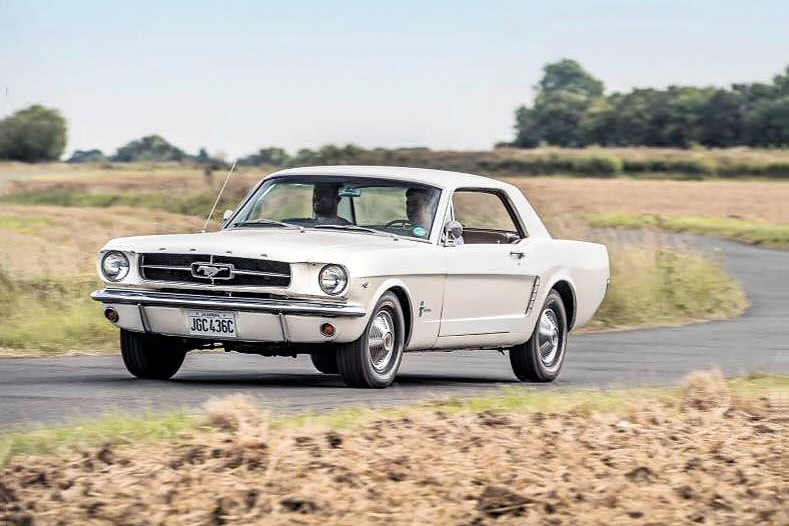
DARRIN’S DREAM DRIVE LIST
Jaguar E-type ‘It has the looks, charm and sheer wow factor’ Lotus Carlton ‘It’ll do 0-60mph in 5 seconds and 178mph, and you can still take the kids to school and pick up your shopping on the way home’
McLaren F1 ‘The first of the hypercars – incredible performance, and with decent practicality as a road car’ Lamborghini Countach LP500 ‘Striking looks, coupled with that V12 roar – who needs practicality and rear vision?‘
Lancia Stratos ‘Another wild car I used to love in my childhood – incredible’
Lotus Elan S1 ‘Ahead of its time, I love its shape and simplicity – rapid, too’
SS Jaguar ‘My father had a fixed-head coupé 2.5 nicknamed “Jaguar George”; beautiful cars’
Datsun 240Z Samurai ‘The Japanese got the looks just right, and to drive a rare Samurai with its triple carburettor conversion would be a real treat’
Aston Martin DB5 or DB6 ‘Do I need to say more?’
DARRIN ALKER’S CAR CV
Ex-navy man Darrin Alker’s car loyalties lie divided between East and West
SUZUKI CS100
‘My first car, which I bought because it looked different from all the Minis and Ford Escorts everyone had back then. The engine was almost mid-mounted, and got to 60mph – eventually. I learned a lot about mechanics on this car. I paid £850 for it in 1986 and sold it for £900 in 1990.’
NISSAN SILVIA TURBO
‘From an era when intercoolers weren’t fitted to road cars; put your foot down, count to three and woosh, away you go. I’ve owned it since 1989 and it was my daily until 2001. It’s still on the original engine and gearbox after 145,000 miles, although it was re-sprayed in 1999. It’s currently of the road because of a failed wheel bearing, which has led to many other jobs…’
NISSAN 200SX S13
‘Not many left because they became the drifter’s dream car and suffered from rust – the main reason I had to let mine go. I loved the pop-up headlights and the sleek lines lost in later versions. Fun, fairly quick and it handled reasonably, if a little tail-happy in the wet.’

LOTUS ESPRIT TURBO
‘I watched one being driven by James Bond in The Spy Who Loved Me and knew I had to have one. Striking, sharp looks make it look like it’s going fast, even when stood still. I’ve had it since 1996 and, after two failed engines, recently fitted a later, brand new one from an S4 Esprit. This is my dream car, the one I had a poster of and the toy car version of.’





